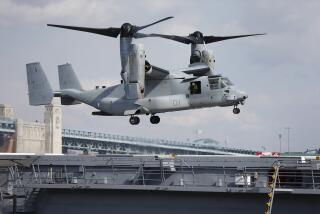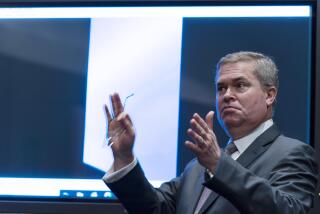Lifting the Veil
- Share via
The two most influential members of the House Armed Services Committee are challenging the need for the super-secrecy shrouding the “stealth” bomber project. Their request for a “detailed” Pentagon justification for keeping the program under wraps is part of the congressional battle between proponents of the stealth, or advanced-technology, bomber and the B-1B bomber. But there is a strong case for Congress’ knowing more about the stealth program.
The stealth project, initiated by President Jimmy Carter, is aimed at developing a bomber that, unlike the old B-52s in the present fleet, will be capable of eluding radar and penetrating Soviet air defenses for years into the future.
When the Reagan Administration decided in 1981 to order 100 B-1Bs from Rockwell International, for delivery in the mid-to-late 1980s, it also confirmed plans to pursue development by Northrop Corp. of the stealth as a follow-on bomber.
The first B-1Bs already have been delivered to the Air Force, and, as things stand, the 100th plane will roll off the production line in 1988. Rockwell is lobbying hard to sell the Air Force an additional 48 B-1Bs at a price of $195 million each--about a third less than the price for the first 100 planes.
However, the Defense Department has told Congress again that it is not interested in buying additional B-1Bs, that it intends to purchase 132 copies of the stealth, or ATB, after delivery of the 100 B-1Bs has been completed. Donald Hicks, undersecretary of defense for research and engineering, has said that the cost per stealth bomber will be within 2% or 3% of the unit price of the first 100 B-1Bs--a price that Rockwell now pledges to lower.
Rockwell’s lobbying effort benefits from the fact that subcontractors all over the country have a financial interest in extending production. But a much more important factor is the squeeze on the defense budget and the need to be sure that the penetrating ATB will in fact be superior to B-1Bs and bombers already in service, if these are equipped with cruise missiles that have radar-eluding capabilities of their own and can be fired from outside Soviet airspace.
Rockwell is credited with doing a good job of holding down costs on the B-1B. Northrop’s Aircraft Division has just won the Air Force’s Contractor Productivity Award for the third consecutive year, and we have no reason to doubt that the stealth bomber project is being well managed, too.
But we have no way of knowing whether the stealth bomber can be brought into service on schedule or whether its military capabilities justify the higher price tag--and neither do members of Congress who must vote on defense appropriations--precisely because of the extreme secrecy that surrounds the stealth program. No specific information has been made public on the cost of the project, much less on the plane’s prospective performance characteristics or Northrop’s progress in turning it from a paper airplane into a deployed weapon system.
Maintenance of the American edge over the Soviets in military technology is extremely important; unusual secrecy is justified in the early stages of programs in which the technology is unusually critical. But when such a program reaches the point where big bucks are involved, and where hard choices must be made between competing weapon systems, the democratic process requires lifting the veil of secrecy enough to allow full and meaningful debate.
That point has been reached, in the view of Reps. Les Aspin (D-Wis.) and William L. Dickinson (R-Ala.), chairman and ranking Republican on the House Armed Services Committee, who are better situated than most of us to know. Stealth cannot reasonably be kept in the closet much longer.
More to Read
Inside the business of entertainment
The Wide Shot brings you news, analysis and insights on everything from streaming wars to production — and what it all means for the future.
You may occasionally receive promotional content from the Los Angeles Times.










